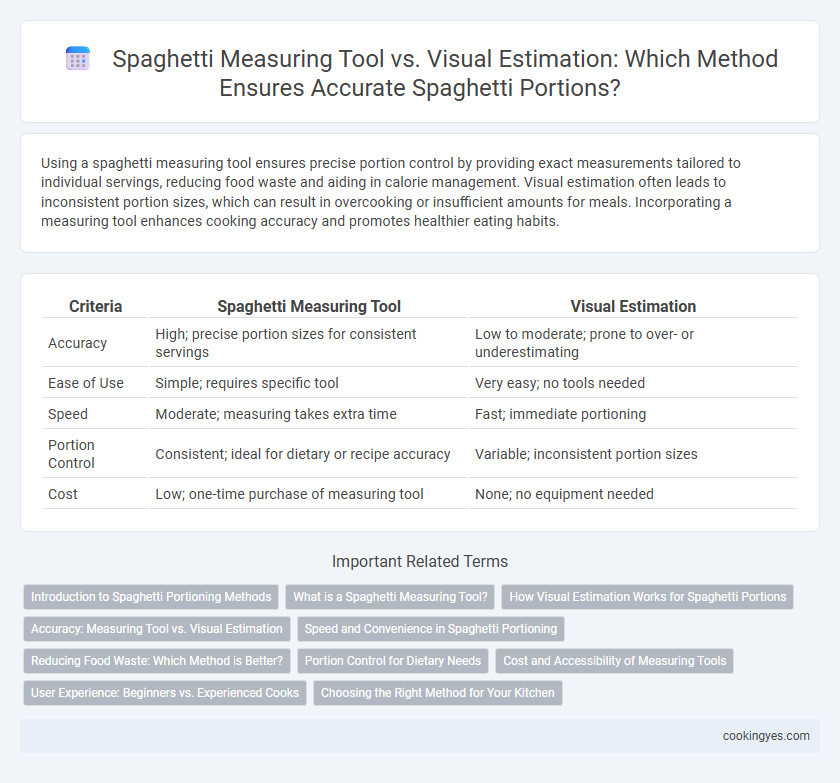Using a spaghetti measuring tool ensures precise portion control by providing exact measurements tailored to individual servings, reducing food waste and aiding in calorie management. Visual estimation often leads to inconsistent portion sizes, which can result in overcooking or insufficient amounts for meals. Incorporating a measuring tool enhances cooking accuracy and promotes healthier eating habits.
Table of Comparison
| Criteria | Spaghetti Measuring Tool | Visual Estimation |
|---|---|---|
| Accuracy | High; precise portion sizes for consistent servings | Low to moderate; prone to over- or underestimating |
| Ease of Use | Simple; requires specific tool | Very easy; no tools needed |
| Speed | Moderate; measuring takes extra time | Fast; immediate portioning |
| Portion Control | Consistent; ideal for dietary or recipe accuracy | Variable; inconsistent portion sizes |
| Cost | Low; one-time purchase of measuring tool | None; no equipment needed |
Introduction to Spaghetti Portioning Methods
Spaghetti portioning methods include specialized measuring tools and visual estimation techniques to control serving sizes accurately. Measuring tools, such as spaghetti portion rings or calibrated cups, provide consistent portions based on weight or volume, reducing food waste and ensuring nutritional balance. Visual estimation relies on experience and simple cues like the diameter of a pasta bundle, offering convenience but less precision compared to dedicated portioning devices.
What is a Spaghetti Measuring Tool?
A spaghetti measuring tool is a specialized kitchen gadget designed to portion pasta accurately by size or number of servings, eliminating guesswork in meal preparation. Typically made of plastic or metal, these tools feature different-sized holes or slots corresponding to specific portion weights, ensuring consistent cooking results and waste reduction. Unlike visual estimation, which can vary widely, using a measuring tool guarantees precise control over serving sizes, aiding in nutrition management and recipe consistency.
How Visual Estimation Works for Spaghetti Portions
Visual estimation for spaghetti portions relies on recognizing common reference points such as the diameter of a bundled noodle strand, often compared to everyday objects like a quarter or a golf ball to gauge a single serving size. Experienced cooks assess the amount by eye, adjusting based on the size of the pot and the number of servings required, often using hand measurements to approximate portion weight or length. This intuitive method speeds up meal preparation but can lead to inconsistent portions compared to precise spaghetti measuring tools designed for exact serving control.
Accuracy: Measuring Tool vs. Visual Estimation
Using a spaghetti measuring tool ensures precise portion control by accurately quantifying servings based on weight or diameter, reducing food waste and aiding dietary consistency. Visual estimation often leads to significant portion size variability, resulting in either over-serving or under-serving, which impacts meal planning and nutritional intake. Studies show measuring tools improve accuracy by up to 30% compared to visual methods, making them essential for consistent spaghetti portioning.
Speed and Convenience in Spaghetti Portioning
Using a spaghetti measuring tool significantly enhances speed and convenience in portioning by providing precise, quick measurements without guesswork. Visual estimation often leads to inconsistent portion sizes, requiring more time for adjustments and increasing the risk of overcooking or waste. The measuring tool ensures accurate servings, streamlining meal preparation and improving efficiency in both home and professional kitchens.
Reducing Food Waste: Which Method is Better?
Using a spaghetti measuring tool significantly reduces food waste by providing precise portion control, ensuring consistent servings that meet dietary needs without excess. Visual estimation often leads to over- or under-serving due to subjective judgment, increasing the likelihood of leftover food or insufficient portions. Accurate measurement tools optimize ingredient use, minimize waste, and contribute to more sustainable kitchen practices.
Portion Control for Dietary Needs
Using a spaghetti measuring tool ensures precise portion control, directly supporting dietary needs by accurately quantifying servings in grams or ounces. Visual estimation often leads to inconsistent portion sizes, risking under or overconsumption of calories and nutrients crucial for balanced diets. Employing a standardized measuring tool optimizes dietary adherence, helping manage intake and maintain nutritional goals effectively.
Cost and Accessibility of Measuring Tools
Using a spaghetti measuring tool ensures precise portion control, reducing food waste and saving money compared to the often inaccurate visual estimation method. While measuring tools may have an initial cost, their long-term savings and consistent portion sizes justify the investment. Visual estimation, although cost-free and instantly accessible, can lead to over- or under-serving, impacting budget and meal quality.
User Experience: Beginners vs. Experienced Cooks
Spaghetti measuring tools provide precise portion control, reducing guesswork and minimizing food waste, particularly benefiting beginners who struggle with visual estimation. Experienced cooks often rely on visual cues developed over time, prioritizing flexibility and speed in meal preparation. While measuring tools enhance accuracy for novices, seasoned chefs balance precision with intuition based on their cooking experience.
Choosing the Right Method for Your Kitchen
Spaghetti measuring tools provide precise portion control, reducing food waste and ensuring consistent serving sizes in both home and professional kitchens. Visual estimation, while faster, often leads to variability and potential over- or under-serving, impacting nutritional accuracy and meal planning. Choosing the right method depends on kitchen volume, desired accuracy, and time constraints, with measuring tools favored for consistency and visual estimation suited for quick, flexible preparation.
Spaghetti measuring tool vs Visual estimation for portioning Infographic

 cookingyes.com
cookingyes.com